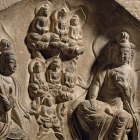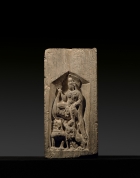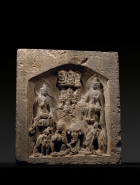J.J. Lally & Co., Oriental Art / New York City, New York
MenuPast Exhibition
Buddhist Sculpture from Ancient China
March 10-31, 2017
14.
A LIMESTONE BLOCK-FORM BUDDHIST STELE
Tang Dynasty, dated by inscription 742
carved with figures in deep niches on two sides, the larger niche with a meeting of the bodhisattvas Manjusri (Wenshu) on a lion and Samantabhadra (Puxian) on an elephant, and with the Seven Buddhas of the Past seated on lotus pods shown floating in the air between the bodhisattvas, the foreground with a muscular foreign attendant standing beside the lion and a slender female adorant holding a lotus bud standing beside the elephant, all carved in high relief with long dedicatory inscriptions on the vertical borders; with another niche on one narrow side adjacent to the principal niche, carved in relief with a figure of Manjusri (Wenshu) on a lion attended by a muscular foreigner, and with a dated dedicatory inscription on one vertical border, the solid block of dense gray stone with weathered surface.
Height 21 7⁄8 x Width 19 3⁄4 x Depth 10 1⁄2 inches (55.6 x 50.2 x 26.6 cm)
Provenance
From the Collection of Edgar Worch (1890-1972)
From the Trubner Family Collection
On loan at the Los Angeles County Museum of Art (1949-2016)
The inscription on the side panel may be read as天寶元年五月卄三日栢思太妻李夫婦二人自為巳□敬造文殊普賢菩薩并業造像一區合家供養 The Tang dynasty reign date at the beginning of the dedication may be read as “first year of Tianbao,” which corresponds to 742. Another inscription beside the front panel is largely illegible but appears to have been modified later in the Tang dynasty.
Two very similar block-form Buddhist stele carved with the same iconography, one of which is dated by inscription to the first year of Tianbao (742), in the collection of the Los Angeles County Museum of Art, donated by the Trubner Family, are illustrated on the museum’s website, AC1998.83.1 and AC1998.83.2.
The “Buddhas of the Past,” representing Buddhas pre-dating the historical Buddha Sakyamuni, may be shown in groups of three, five, or seven in the halo of a Buddha or as part of an assemblage of sacred images in a shrine. Two similar arrangements of the Seven Buddhas of the Past included in Tang dynasty gilt bronze groups are illustrated by Munsterberg, Chinese Buddhist Bronzes, New York, 1988, pl. 36, in the Museum of Far Eastern Art, Cologne; and pl. 37, in the St. Louis Art Museum, with a discussion of the origins and various examples of the iconography, op. cit. pp. 59-62.
唐 天寶元年款 青石佛龕 高 55.6 寬 50.2 深 26.6 厘米
出處
Edgar Worch (1880-1972) 舊藏
Trubner 家族舊藏
1949-2016年借展於洛杉磯郡博物館


